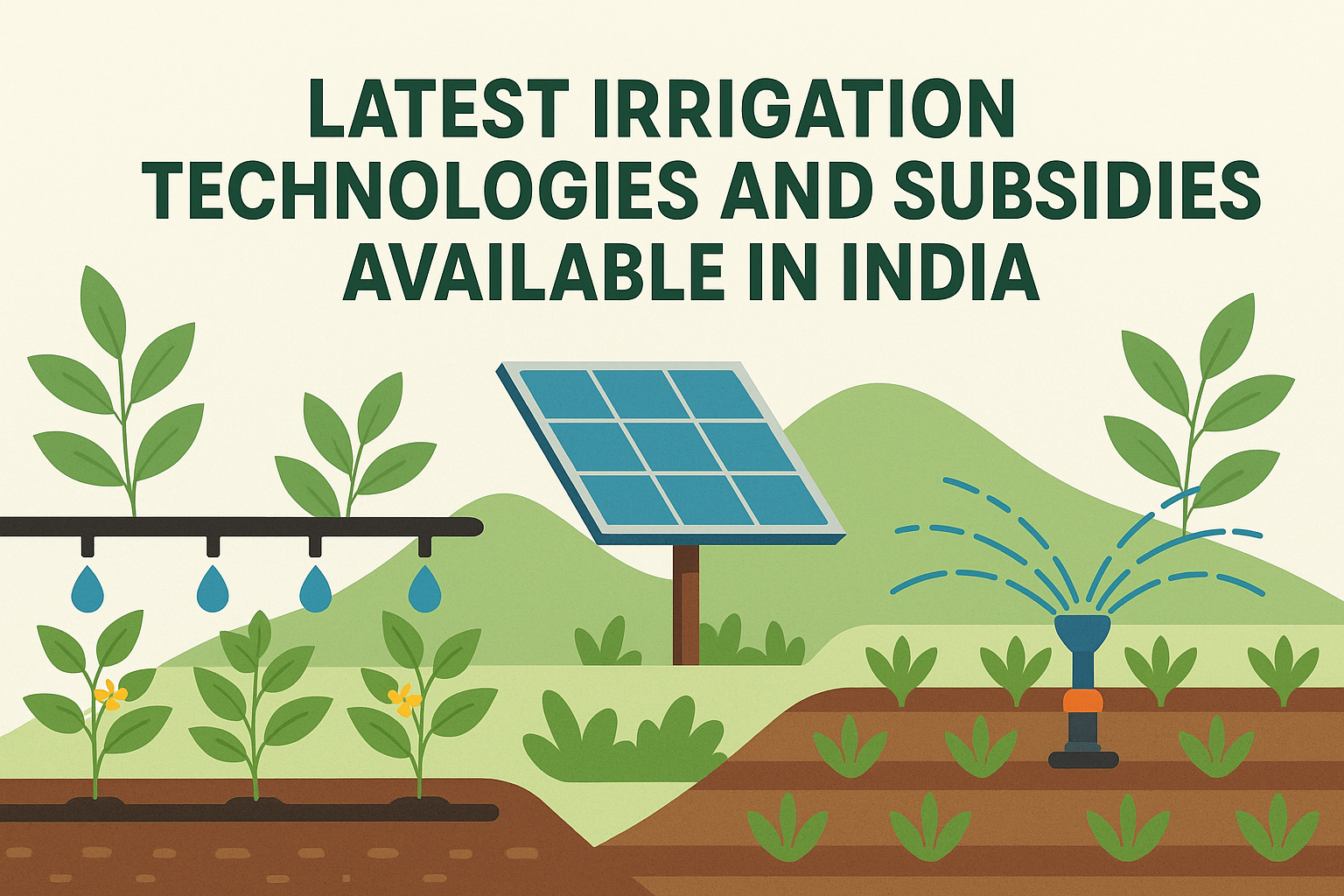
Latest Irrigation Technologies and Subsidies Available in India
Water is the lifeline of farming. Every crop depends on it. But with rainfall becoming uncertain and the cost of farming going up, saving water has become just as important as growing crops. We all know the simple truth: “Jal hai, toh kal hai” - if there is water, there is a future.
The real challenge for farmers today is how to water crops in a way that saves every drop, keeps the soil healthy, and reduces our worries about groundwater. Imagine if plants got water exactly when they needed it, drop by drop, without wastage. And imagine if the government helped us install these systems through subsidies.
That is exactly what modern irrigation technologies are making possible. Let’s look at the latest techniques that farmers across India are adopting, and the schemes that can make them affordable for you too.
Why Modern Irrigation is Important
Traditional flooding of fields wastes a lot of water. Many times, water does not even reach the roots properly. This means higher bills, more effort, and lower output. Modern irrigation systems ensure that every drop of water is used wisely. They also reduce the use of electricity, labour, and fertilizer.
Latest Irrigation Techniques for the Modern Indian Farmers
1. Drip Irrigation (The 'Boondu' (Drop) Method)
Drip irrigation gives water straight to the roots of the plants, drop by drop. A network of pipes with tiny holes (drippers) is laid along the crop rows, which slowly releases water at the base of each plant.
- Saves 50-70% water compared to flood irrigation.
- Prevents weed growth, since only the plant area gets water.
- Helps in giving higher yields with less water.Very effective for crops like sugarcane, cotton, grapes, banana, and vegetables.
2. Sprinkler Irrigation
This system works just like natural rain. Water is pushed through pipes and sprayed into the air from sprinkler heads placed at regular intervals, falling gently on the crops.
- Best suited for light soils, where water can soak in quickly.
- Works well even on uneven land, where flood irrigation is difficult.
- Useful for crops like wheat, pulses, mustard, groundnut, and fodder.
- Sprinklers keep soil moisture balanced across the entire field.
- The system is portable, so it can be shifted from one field to another when needed.
3. Solar-Powered Irrigation Systems
With electricity costs rising and supply often unreliable, solar pumps are becoming a smart choice for many farmers. They use the sun’s energy to run your water pump during the day. Solar panels installed in the field capture sunlight and convert it into electricity, which powers the pump motor to draw water.
- No electricity bills, sunlight is free.
- Reliable water even in areas with frequent power cuts.
- A one-time investment that gives long-term savings.
- Reduces dependence on diesel or grid electricity.
4. Micro Sprinklers and Rain Guns
Micro sprinklers and rain guns are advanced types of sprinklers that make irrigation easier for different needs.
- Micro sprinklers are gentle and perfect for vegetables, flowers, and nurseries where crops need soft watering.
- Rain guns release a higher volume of water quickly, making them ideal for sugarcane, potato, and other water-demanding crops.
- Can cover larger areas in less time compared to normal sprinklers.
- Useful for both small and big farms, depending on crop needs.
5. Automated Irrigation Systems
Automated systems use sensors and timers to give water only when the soil becomes dry. This ensures crops get exactly what they need.
- Saves water, electricity, and labour.
- Prevents both over-watering and under-watering.
- Still new in India, but slowly being adopted by progressive farmers and cooperatives.
- A step towards modern, efficient farming.
6. IoT & Sensor-Based Irrigation
This may sound technical, but it’s actually very simple. Small devices called sensors are placed in the field to measure how much moisture is in the soil. The data is sent directly to your mobile phone.
How it works: The sensor alerts you when the soil is dry. With just a tap on your phone, you can start or stop your drip or sprinkler system, even if you are away from the village.
- No more guessing when to water.
- Prevents both over-watering and under-watering.
- Keeps crops healthier and stronger.
- Saves time, water, and effort.
Government Subsidies and Schemes: How They Help You Pay For It?
The Government of India, through the Pradhan Mantri Krishi Sinchai Yojana (PMKSY), provides subsidies for drip and sprinkler irrigation. Under this, you can get a subsidy meaning the government pays for a part of the system's cost, and you only have to pay the rest. Farmers can get 45-55% subsidy (and sometimes more for small and marginal farmers). Many state governments also give additional benefits on top of this.
For example:
- Gujarat and Maharashtra offer higher subsidies for horticulture crops.
- Rajasthan supports sprinkler systems for arid zones.
- Karnataka and Andhra Pradesh promote micro irrigation for fruits and vegetables.
How to Apply for Subsidy
Applying for irrigation subsidies is a simple process if you follow the right steps:
- Contact your local Agriculture Officer (Krishi Adhikari) or Block Development Officer (BDO). They will guide you with the latest scheme details.
- Visit your nearest Krishi Vigyan Kendra (KVK) or agricultural university for advice and support in filling out forms.
- In many states, you can also apply online through government portals.
- If you’re not comfortable with the online process, your agriculture officer can help.
Documents usually required: Aadhaar card, land records, and bank account details.
Tip: Always ask for the list of approved companies and equipment under the scheme. This makes sure you get good quality products and that your subsidy claim is processed smoothly.
How Farmers Benefit from these Systems
- Save more water, save more money, modern systems use every drop wisely.
- Healthier crops because plants get the right amount of water at the right time.
- Less labour needed since many systems can run on their own or with little effort.
- Fertilizers can be given through drip, so there’s no wastage and crops get nutrients directly at the roots.
- Government subsidies reduce the initial cost, making it easier to adopt these technologies.
Irrigation Choices That Shape the Future
Water will always be the heart of farming, and using it wisely is the need of the hour. Modern irrigation systems whether it’s drip, sprinkler, solar pumps, or sensors help farmers save water, reduce costs, and grow healthier crops. With government support through subsidies, these technologies are not out of reach.
For farmers, it’s not about big changes overnight, but about taking small steps that make the farm stronger year after year. Even adopting one of these methods can make a real difference. After all, when water is saved, farming becomes more secure for the future.
At Khetavya, we provide irrigation solutions that help farmers choose and adopt the right method for their fields. From drip to sprinklers, our focus is on making water use simple, efficient, and farmer-friendly.
